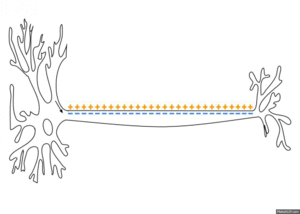To understand how they work, let's begin with the actual nerve cells themselves:
Here's a labeled image of a false-color photograph, so you can see what they actually look like when they aren't a simplified diagram:

Bit hard to tell the front from the back, innit?
We've discussed how signals are transferred between neurons in an earlier post, and throughout the "How Drugs Work" series, so we can skip all that and move on to how those signals travel down the individual nerve cells.
When people are first introduced to how electricity works, we can use water as a fairly decent metaphor for what's happening. Even though it's not entirely accurate, we can think of electrons like water molecules (and wires as pipes, voltage as water pressure, etc...) in order to visualize what's happening when we look at a complicated system. Unfortunately, this analogy does not apply to how signals travel through neurons. Toss it out the window now so we can proceed.
When a neuron receives the signal to fire from another neuron, it's less like anything actually moving from one place to another, and more like someone just tipped over the first domino in a line. When you start a line of dominos falling, a thing happens. You can see the thing moving down the line until it reaches the end, and then you need to pick up everything and set it up again if you want the dominoes to do the thing again.
You can watch these two Kahn Academy videos: and for a full, detailed explanation of how this process works in a nerve cell, which I do recommend, but since you're here, you probably want the short version.
So here's the deal with the Action Potential: you have both sodium and potassium ions floating about both inside and outside of your nerve cells, both of which are positively charged. Now, as a baseline, there will be more positively charged ions OUTSIDE the cell that INSIDE the cell. Things don't want to be like that. Things want to be neutral.
Imagine you have a box with a divider in the middle and a bunch of marbles. If you put a bunch of marbles on one side, and then lift up the divider, all the marbles are going to flow under the divider until there is an even layer of marbles at the bottom of the box, with approximately the same number of marbles on each side. Even if you have some marbles on the other side already.

Get it?
As long as that barrier is in place, the red marbles on the one side of the box aren't going anywhere. Same deal with all that sodium floating around outside the cell. Nerve cells actually do have little gates that allow for the passage of sodium into the cell, however, and it's these gates that open with the dendrites receive a signal to fire.
Step 1. Signal received, and first sodium gates open, allowing positively charged ions to flood into the cell.

Step 2. As sodium ions enter the cell, the change in the concentration of these ions causes the next gates down the line to open, allowing even more stuff to enter the axon, and in doing so, carry the signal forward.
Step 3. In addition to opening the sodium gates down the line, the influx of positive ions in the cell causes the cell to begin pumping those same ions right back out again, thus resetting the cell and making it ready to fire again (like setting up the dominoes all over again, or closing the marble-barrier, and then putting all the marbles into the other side again.) Until the original imbalance is restored, the nerve will not be able to fire again.
Like so.
So why am I telling you this? Because the bottom line is that unlike electrical wires, where a signal is a signal is a signal, our nervous systems have several potential sources of failure and delays. Not only because of the manner in which our nerves work, but also due to the fact that our brains them have to turn around and interpret every signal they receive.
In the case of the nerve impulse, the average time taken to "reset" the cell is about 5 milliseconds. That means you need at least that much time between stimuli to tell if something has changed. This is why, if I were to tap you in the forehead at a rate faster than once every 5 milliseconds, you might not be able to even tell I was lifting my finger at all. It would seem like a single, continuous touch.
Consider also the effort involved in processing the information our brains receive. If I were to tap you on the nose and on the tip of your big toe simultaneously. You'd feel those two signals at the same time. Yet, the signal from your big toe would have to travel the entire length of your body to reach your brain, while the one from your toe only has to travel a few inches. Your brain waited to tell you that two signals had arrived from two different places. It got the signal from your nose, and then waited to see if anything else happened during that same time period, and then reported the event to the rest of you.
You aren't experiencing reality in real time, and this has profound influences on how we interpret and respond the world around us.

This analogy does not apply to how signals travel through neurons. Toss it out the window now so we can proceed.http://www.stockholmfreetour.com
ReplyDeleteIt was truly incredible to discover such an astonishing web journal on the web.
ReplyDeletefree walking tour stockholm
This blog has left its gathering of spectators completely enchanted.
ReplyDeleteaquí